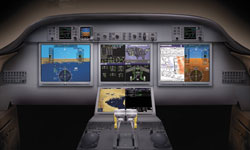Cessna to build largest-ever Citation jet
By Paul Richfield
 Cessna Aircraft has unveiled plans to develop the Citation 850 Columbus, an eight-seat twinjet slated to fly 4,000 nautical miles at Mach 0.80, or from Munich to New York nonstop against the worst winter winds.
Cessna Aircraft has unveiled plans to develop the Citation 850 Columbus, an eight-seat twinjet slated to fly 4,000 nautical miles at Mach 0.80, or from Munich to New York nonstop against the worst winter winds.
The largest and longest-range Citation ever, the Columbus will debut two new component technologies: The Pratt & Whitney Canada PW810—first of a family of “green” turbofans—and the Rockwell Collins Pro Line Fusion integrated avionics system.
“This is a new market for Cessna, an opportunity for us to take our customers to new parts of the world nonstop,” said Cessna CEO Jack Pelton, speaking to a gathering of news media at the Willard Intercontinental Hotel in Washington, D.C., on Feb. 6.
Pelton sees a market for around 500 Cessna 850s and derivative models over the life of the program, with more than 70 letters of intent and deposit commitments received to date. Of these, around 50 are from non-U.S. customers with many, ostensibly, seeking to capitalize on the weak U.S. dollar.
“Now the challenge is to convert those LOIs into firm orders, and we’re confident that we can,” said Roger Whyte, Cessna’s senior vice president of sales and marketing. “We started exploring this concept six years ago; Citation operators wanted the ability to step up to a large cabin airplane with a flat floor and a baggage compartment accessible in flight.”
Cessna said the 850 will require $780 million in total development cost—a commitment the Textron board of directors approved on Jan. 23. Priced at $27 million, the Columbus most directly competes with the Bombardier Challenger 300 and 605, and the Dassault Falcon 2000EX.
Wichita, Kan.-based Spirit AeroSystems will build the 850’s fuselage and tail section; a wing provider has yet to be named. Construction will be largely conventional aluminum, with composites used as needed.
Pratt & Whitney Canada said its PW800 family of 10,000-pound-thrust class engines, which debut on the 850, will aim to exploit the latest materials and design concepts, and offer decreased fuel burn, emissions and noise levels quieter than Stage IV. The PW810 earmarked for the 850 will produce 8,830 pounds of thrust.
 Up front, the Rockwell Collins Pro Line Fusion avionics will consist of four, 15-inch liquid crystal displays mated to graphical flight planning, synthetic/enhanced vision, autothrottles, the new MultiScan radar and an optional head-up display.
Up front, the Rockwell Collins Pro Line Fusion avionics will consist of four, 15-inch liquid crystal displays mated to graphical flight planning, synthetic/enhanced vision, autothrottles, the new MultiScan radar and an optional head-up display.
First flight of the Columbus prototype is planned for 2011, with FAA certification slated for 2013 and initial customer deliveries following in 2014.
February 7, 2008


